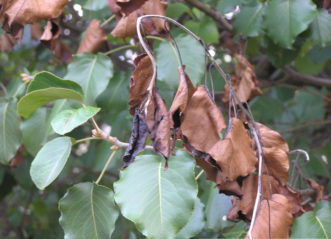Wanted: Disease on Bradford Pear
go.ncsu.edu/readext?866424
en Español / em Português
El inglés es el idioma de control de esta página. En la medida en que haya algún conflicto entre la traducción al inglés y la traducción, el inglés prevalece.
Al hacer clic en el enlace de traducción se activa un servicio de traducción gratuito para convertir la página al español. Al igual que con cualquier traducción por Internet, la conversión no es sensible al contexto y puede que no traduzca el texto en su significado original. NC State Extension no garantiza la exactitud del texto traducido. Por favor, tenga en cuenta que algunas aplicaciones y/o servicios pueden no funcionar como se espera cuando se traducen.
Português
Inglês é o idioma de controle desta página. Na medida que haja algum conflito entre o texto original em Inglês e a tradução, o Inglês prevalece.
Ao clicar no link de tradução, um serviço gratuito de tradução será ativado para converter a página para o Português. Como em qualquer tradução pela internet, a conversão não é sensivel ao contexto e pode não ocorrer a tradução para o significado orginal. O serviço de Extensão da Carolina do Norte (NC State Extension) não garante a exatidão do texto traduzido. Por favor, observe que algumas funções ou serviços podem não funcionar como esperado após a tradução.
English
English is the controlling language of this page. To the extent there is any conflict between the English text and the translation, English controls.
Clicking on the translation link activates a free translation service to convert the page to Spanish. As with any Internet translation, the conversion is not context-sensitive and may not translate the text to its original meaning. NC State Extension does not guarantee the accuracy of the translated text. Please note that some applications and/or services may not function as expected when translated.
Collapse ▲One of the earliest, and most recognized spring-blooming trees is the ornamental pear commonly referred to as ‘Bradford’ pear. It is from the species of Callery pear (Pyrus Calleryana) that originated in China and is one of its oldest cultivars. ‘Bradford’ pear was introduced into our landscape in the early 1960s as a temporary (10-20 year) specimen tree in residential and commercial sites, school grounds and shopping malls. It was planted because of its desirable shape, rapid growth rate and its adaptability to different soil conditions. It is relatively disease and pest free, but alongside that which is normally considered good news, also comes some bad.
The ‘Bradford’ pear is not able to bear fruit that is viable due to its sterile nature. However, cultivars that were later developed were able to cross-pollinate with this  selection and produce viable offspring which escaped to roadsides and fencerows. These offspring bear long, sharp thorns and have spread into natural forests, replacing native trees due to their rapid growth and the overabundance of ‘Bradford’ pears that were planted.
selection and produce viable offspring which escaped to roadsides and fencerows. These offspring bear long, sharp thorns and have spread into natural forests, replacing native trees due to their rapid growth and the overabundance of ‘Bradford’ pears that were planted.
The disease known as fire blight affects members of the Rosaceae (rose) family including apple, pear, crabapple, pyracantha, photinia, quince, loquat and hawthorn. The bacteria enters through flower blossoms or wounds in the tree and is more conducive during cool, wet springs. Flowers turn black and die as the disease moves down branches and causes young twigs to blacken and curl over, resulting in the telltale “shepherd’s hook”. Leaves wilt and blacken but remain attached, giving the plant a fire-scorched appearance. Insects and rain can spread the disease. Although ‘Bradford’ pear has considerable resistance, its cross-pollination with cultivars has resulted in self-sustained populations of wild callery pear trees that can spread the disease to apple and pear orchards and into home landscapes. Susceptible varieties have substantially more damage.
Cedar quince rust is also a disease of ornamental pear that alternates between the Rosaceae family and the Juniperus (juniper) family. In cool, wet springs, the fungal pathogen spreads by spores from nearby infected junipers, like the Eastern red cedar, to plants such as pear, hawthorn and serviceberry. Tiny bright orange surface bumps appear on leaves and blooms leaving damage that appears similar to fire blight but generally affects only the branch tips. It may significantly reduce seed production, but does not move throughout the tree. There are no recommended controls for fire blight or cedar quince rust on ‘Bradford’ pear. For more information, read our article on the fire blight.
‘Bradford’ pears are structurally weak trees. Their narrow crotch angles make them highly susceptible to breakage by wind and ice. Their thousands of blossoms at peak have a smell that is described as that of “a decaying animal”. They are now considered a noxious invasive species, so much in fact that there is a bounty program that has been implemented in North Carolina to help with the replacement of ‘Bradford’ pear with native trees. For details, check out our article on the ‘Bradford’ pear bounty. Alternatives to planting ‘Bradford’ pear include flowering dogwood, kousa dogwood, fringe tree and Carolina silverbell.
‘Bradford’ pear once filled a niche in our landscape, but its qualities proved detrimental to what is left of our native woodlands. This once temporary specimen has reached its end time. It is time to say “good-bye”. So long. Farewell By the way, you stinketh.
Gail Griffin is an Extension Master Gardener Volunteer with North Carolina Cooperative Extension in Lee County.




